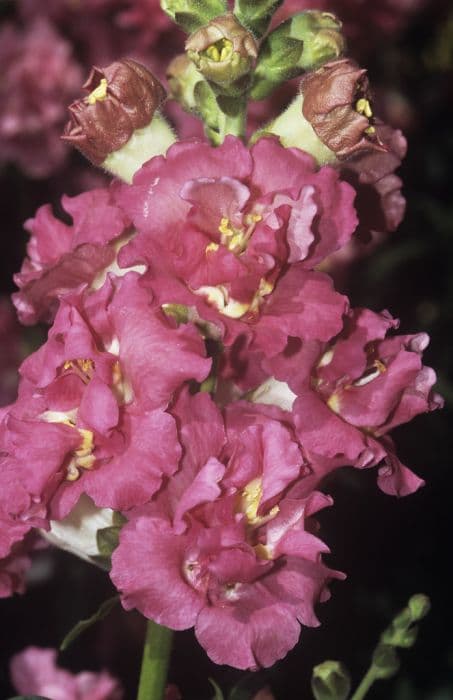Mexican Viper Maurandya barclayana

ABOUT
The plant commonly known as the Mexican Vining Snapdragon has a climbing and sprawling habit, making it an eye-catching sight when it is used to adorn walls, trellises, or other structures it can cling to. The leaves of the Mexican Vining Snapdragon are heart-shaped, creating a lush backdrop for the flowers. These leaves grow in an alternating pattern along the vine, and their deep green color offers a nice contrast to the colorful blooms. The flowers themselves are the real showstoppers. They blossom in a trumpet shape, similar to what you would see in a traditional snapdragon, and display a wide range of hues including purples, blues, and occasionally whites. They often have a lighter, almost white throat, which may be decorated with intricate venation or patterns. The petals are slightly ruffled, and they flare elegantly at the mouth, giving a fluted appearance that adds to their visual appeal. Adding to their charm, the blossoms can emerge prolifically under the right conditions, sometimes creating a cascade of color that drapes over whatever the vine is climbing. The overall appearance of the Mexican Vining Snapdragon is one of romantic, cascading abundance, with its heart-shaped foliage and resplendent, colorful flowers that attract both the eye and various pollinators such as bees and hummingbirds. Its beauty makes it a favorite among gardeners looking to add vertical interest and a touch of the dramatic to their gardens.
About this plant
 Names
NamesFamily
Plantaginaceae.
Synonyms
Barclayana Vine, Mexican Viper, Chickabiddy, Asarina.
Common names
Asarina barclaiana, Lophospermum barclayanum
 Toxicity
ToxicityTo humans
As of my last knowledge update in early 2023, the plant known as the Mexican Viper, Maurandya barclayana, is not widely recognized as a toxic or poisonous plant to humans. There is a lack of substantial evidence or reports indicating that it poses significant health risks when touched or ingested. However, as with many plants, individuals may have differing levels of sensitivity, and it's always prudent to exercise caution and avoid ingesting plant parts unless they are known to be safe. It is advisable to consult with a medical professional or a poison control center for the most current information regarding its toxicity to humans.
To pets
Information on the toxicity of the Mexican Viper, Maurandya barclayana, to pets is not well-documented, and as of my last knowledge update in early 2023, there are no specific reports indicating that it is poisonous to household pets. However, caution should still be exercised to prevent pets from ingesting plants as they could potentially cause gastrointestinal upset or other issues due to individual sensitivities or non-toxic-related reactions. In case of any signs of illness following ingestion, it is recommended to contact a veterinarian immediately for advice.
 Characteristics
CharacteristicsLife cycle
Perennials
Foliage type
Deciduous
Color of leaves
Green
Flower color
Purple
Height
10 feet (3 meters)
Spread
3 feet (1 meter)
Plant type
Climber
Hardiness zones
9
Native area
Mexico
Benefits
 General Benefits
General Benefits- Aesthetic appeal: The climbing vine of the Mexican Vasevine adds visual interest to gardens with its attractive foliage and bell-shaped flowers.
- Attracts pollinators: The flowers provide nectar for hummingbirds and bees, supporting local ecosystems.
- Versatility in landscaping: It can be trained on trellises, arbors, or fences, or used as a ground cover, making it adaptable to a variety of garden designs.
- Drought tolerance: Once established, Mexican Vasevine is relatively drought-tolerant, requiring less water compared to other garden plants.
- Fast growth: It's a quick-growing plant which allows for rapid coverage and filling in of garden spaces.
- Low maintenance: Requiring minimal care once established, it is ideal for gardeners seeking low-maintenance options.
 Medical Properties
Medical PropertiesThis plant is not used for medical purposes.
 Air-purifying Qualities
Air-purifying QualitiesThis plant is not specifically known for air purifying qualities.
 Other Uses
Other Uses- The climbing nature of Maurandya barclayana, also known as the Mexican Viper, makes it a useful plant for covering unsightly fences or walls, creating a more aesthetically pleasing garden space.
- With its attractive flowers, the Mexican Viper can be used as a companion plant in vegetable gardens to encourage pollinators to visit and thereby potentially improve crop yields.
- This plant can be grown in hanging baskets where its cascading vines and flowers can adorn patios, balconies, or indoor settings with a touch of natural beauty.
- Due to its rapid growth, the Mexican Viper can be employed in educational settings to demonstrate the principles of plant growth and vine behavior to students.
- With its dense foliage, Maurandya barclayana can provide a natural privacy screen on balconies or in small urban gardens where space is at a premium.
- Gardeners can use the Mexican Viper's twining vines to create living sculptures by training them over frames or trellises, offering a dynamic element to garden design.
- The plant can be used in butterfly gardens to provide nectar for a variety of pollinators, thus enhancing biodiversity and making outdoor spaces more environmentally friendly.
- Hobbyists who practice the art of topiary may find Maurandya barclayana a suitable subject for creating small-scale living art due to its flexible stems.
- Creative gardeners might use the Mexican Viper as a living curtain on a porch or pergola to create a whimsical and inviting outdoor room.
- The vibrant flowers of the plant can be used as a natural dye source for fabrics, offering a sustainable alternative to synthetic dyes.
Interesting Facts
 Feng Shui
Feng ShuiThe Mexican Vining Snapdragon is not used in Feng Shui practice.
 Zodiac Sign Compitability
Zodiac Sign CompitabilityThe Mexican Vining Snapdragon is not used in astrology practice.
 Plant Symbolism
Plant Symbolism- Aspiration and Achievement - The vigorous climbing habit of the Maurandya barclayana, or Mexican Viper, symbolizes the aspiration to reach higher grounds and the achievement of one's goals.
- Elegance and Beauty - With its delicate and ornate flowers, the Mexican Viper represents beauty and a graceful presence.
- Adaptability and Resourcefulness - As this plant can adapt to various growing conditions, it symbolizes the ability to adjust and thrive in diverse environments.
 Water
WaterThe Asarina, or Mexican Vining Snapdragon, prefers consistently moist soil but not waterlogged conditions. Water the plant deeply when the top inch of soil feels dry to the touch, which might be once a week, depending on the climate and soil type. During active growth periods in spring and summer, watering might be more frequent, while in the fall and winter, reduce watering as the plant's growth slows down. A general guideline might be to provide about 1 gallon of water every week during the growing season, adjusting according to weather conditions and the plant's response.
 Light
LightMexican Vining Snapdragon thrives in full sun to partial shade environments. The ideal location is a spot where the plant can receive bright, indirect sunlight for several hours a day. If grown indoors, placing it near a south or west-facing window will ensure it gets enough light without being scorched by the intense afternoon sun. Adequate light is crucial for vigorous growth and flowering.
 Temperature
TemperatureMexican Vining Snapdragon performs well in a range of temperatures, ideally between 50°F and 85°F. It can survive minimum temperatures down to around 40°F but should be protected from frost. During summer, when temperatures can soar, ensure it is not exposed to conditions hotter than 90°F to avoid stress on the plant.
 Pruning
PruningPrune the Mexican Vining Snapdragon to maintain its shape, encourage bushiness, and remove any dead or damaged growth. Pruning is best done in early spring before new growth starts. Pinch back the tips of the stems periodically throughout the growing season to promote more branching and a fuller plant.
 Cleaning
CleaningAs needed
 Soil
SoilBarclaya typically thrives in a soil mix with good drainage. A blend of equal parts peat, loam, and sharp sand or perlite is ideal. A soil pH range of 6.0 to 7.5 is suitable for Barclaya, enabling the plant to absorb nutrients effectively.
 Repotting
RepottingBarclaya, also referred to as Mexican Vining Snapdragon, should be repotted every two to three years in fresh, well-draining soil to prevent root-bound conditions and to replenish nutrients.
 Humidity & Misting
Humidity & MistingMexican Vining Snapdragon prefers moderate to high humidity levels, ideally around 40-50%, but it is adaptable and can tolerate lower humidity levels common in most homes.
 Suitable locations
Suitable locationsIndoor
Place Barclaya in bright, indirect light; keep soil moist.
Outdoor
Plant Barclaya in partial shade; protect from strong winds.
Hardiness zone
9-11 USDA
 Life cycle
Life cycleMaurandya barclayana, commonly known as the Mexican Viper, begins its life cycle as a seed, requiring a period of stratification or a simulation of winter conditions to break dormancy. Upon germination, the seedling emerges and develops its first set of true leaves, entering the vegetative growth stage where it focuses on root and foliage development. As a climbing perennial, it develops tendrils and uses other structures for support to maximize sunlight exposure. Following the vegetative phase, the Mexican Viper transitions to the flowering stage, producing tubular flowers that attract pollinators such as bees and hummingbirds for sexual reproduction. After pollination, it sets fruit in the form of a capsule that contains numerous seeds, which when mature are dispersed by various means, including wind and gravity. The plant may enter a period of dormancy during colder months, only to resume its growth cycle with the return of favorable conditions.
 Propogation
PropogationPropogation time
Spring to summer
The most popular method of propagation for the plant commonly known as "Twining Snapdragon" or "Chickabiddy" (Maurandya barclayana) is through seeds. Seeds can be sown in early spring in warm conditions, ideally at temperatures around 70 degrees Fahrenheit (approximately 21 degrees Celsius). Fill a pot or tray with well-draining seed starting mix and lightly press the seeds into the soil, covering them with a thin layer of soil or vermiculite. The medium should be kept consistently moist but not waterlogged. Place the tray in a bright location without direct sunlight, which can impede germination. Seedlings usually emerge in 14 to 28 days and can be transplanted outdoors once the threat of frost has passed and they have developed several true leaves.





![Snapdragon [Pretty in Pink]](/_next/image?url=https%3A%2F%2Fplants-admin.emdemapps.com%2Fimages%2Fplants%2F%2Fimages%2F604b5cb3b5385.png&w=640&q=75)



